New Field Gear Stresses Speed, Convenience
SEATTLE—Speed—the faster a news photographer can get shooting, then get on to the next location, the more productive he or she can be. As the sign over Charles Osgood’s radio reporting desk reads: “Quantity is Job One.”
LIGHTING
The lights a news photog carries are a good place to start. Adding attachments to a piece of equipment can be a real time waster, which is why Zylight built an articulating arm into its LED Newz on-camera lighting fixture (see review). When not in use, the arm folds up to the light fixture’s housing and when it’s showtime, the arm quickly attaches to the camera and allows movement of the light into the desired position.
The Newz fixture provides variable color temperature adjustment from daylight to tungsten, along with smooth dimming. It sports a water-resistant IP54 rating for shooting in extreme conditions like hurricanes and blizzards.
Whether in the studio or out in the field, today’s cameras offer high resolution and sharpness that can reveal every flaw and blemish on a reporter or interviewee’s face. The solution is a wide, soft source, like Kino Flo’s Diva 415, a four-bank fluorescent fixture that can be interchangeably lamped for daylight or tungsten.
Diva lights provide on-board ballast dimming and feature builtin barn doors along with a reflector, louvers, Flozier diffuser, lamp case and fixture carrying case. Kits combining Diva 415s and the smaller 201s provide all the fixtures needed for a full-fledged interview setup.
The color rendering properties of metal-halide gas discharge lamps, HMIs, MSRs, etc., are well known. But since many of these lamps require time for cooling before being restruck, the off-again/on-again nature of news shooting made their use for “run-and-gun” shooting problematic.
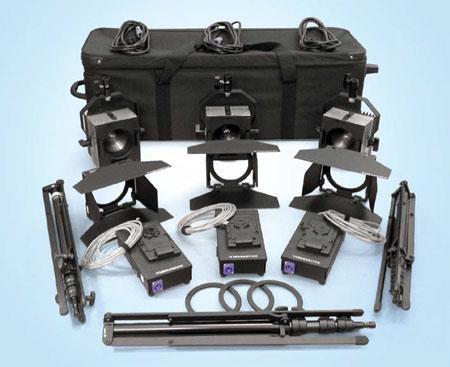
Videssence Little VID KIT K5600’s Joker 200 News provides an ultra-fast restrike lamp starter that assures quiet and immediate lamp ignition and re-ignition, so the fixture requires virtually no setup time. It can be used without optics to become a Bug-Lite, while it can also evenly fill a Lightbank or Lantern, making it the perfect light for interviews. The company’s Joker News kit operates in 110V and 240V environments as well as from a pair of 14.4V camera batteries or a 30V battery.
Get the TV Tech Newsletter
The professional video industry's #1 source for news, trends and product and tech information. Sign up below.
Three-point lighting is a staple of modeling a face, and Videssence’ Little VID KITS are designed to deliver just that in a rolling canvas trolley case. The kits are available in daylight or tungsten, with 50W focusing or non-focusing LED Fresnel fixtures.
Each Little VID fixture is powered off 120-230V AC power, with battery power an option. The kits include stands, barn doors and gel frames or gel holders. Each fixture has a 12-foot cord to remote power supply that allows easy programming for dimming or DMX control.
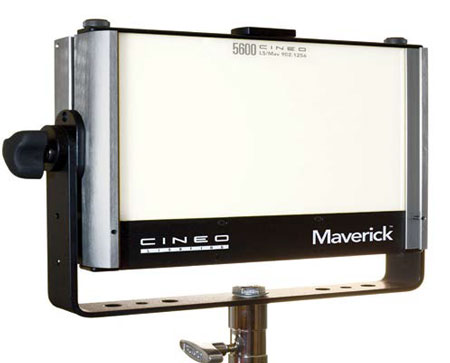
Cineo Maverick The 12 x 12-inch 1x1 LED panel lights have defined soft source lighting for over a decade. Cineo’s Maverick fixture applies its remote phosphor design to that same form factor to take the best of both advantages, with a 160-degree even spread of light and full, on-fixture dimming control. The phosphor panels can quickly be interchanged to change color temperature from 3200 to 5600 or 6500K.
With the rigors of field use in mind, the lightweight Maverick features DC power and waterproof construction and delivers a volume of light equal to a traditional 1K soft source, with a wide array of accessories, power supply and mounting options.
Podcasters and traveling correspondents often deliver their on-camera work from a desktop with a laptop webcam. BBS Lighting took the challenge of image quality from a minimal workspace when it designed its two-light Pipeline Remote Phosphor LED Reporter Kit.
The foot-long cylindrical fixtures come with desktop stands and full range dimming to provide modeled light to match illumination on the correspondent whether in a dimly lit room all the way to filling in sunlight-generated shadows. Using battery power at a paltry 10W per fixture, there’s no need to string power cables.
POWER SUPPLIES
There’s an old news photographer joke that has him looking for a “currant” bush to plug into when his batteries run down. But drained batteries are no joke in the field, and that keeps fueling battery development.
With many newsrooms migrating to one-man-band VJ operations, headcount may be reduced, but the actual number of field-ready camera systems—and their attendant rechargeable batteries—can increase. The more batteries a station has, the more charging wherewithal they need.
PAG found a way to maximize the amount of charging that can be done in the footprint of a single charger by developing its PAGlink system. The four-position PL16+ allows up to four PAGlink batteries to be piggybacked on each of four charging positions to simultaneously charge up to 16 batteries simultaneously. Intelligence built into the system figures out the best and most efficient way of charging each battery pack.
A news shooter carrying a large-enough capacity battery pack to power multiple devices is one thing, but getting at that power can be another.
This led IDX to put a pair of D-taps on its Duo 95 and Duo 150 battery packs, which can power other devices that need a 12V source. And because there are other peripherals like cellphones and tablets that can need a charge during the workday, they’ve even added a USB port to the battery packs.
With all the ways of going live from news stories, it’s important that the photogs be ultra portable and able to move fast and get to the scene first.
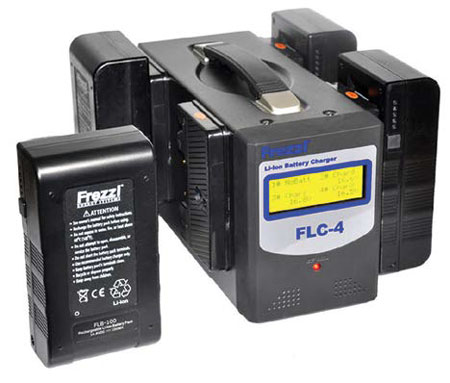
Frezzi FLB-100 Frezzi came out with its FLB (Frezzi Lithium Battery) 100 series with enough power and life to provide power to not only the camera but also on-camera light and bonded cellular transmitter, cutting down on the bulk and weight that several batteries would add. The companion charger is the four-position FLC-4.
Anton/Bauer developed its Gold Mount battery pack attachment system that became so synonymous with the company it’s commonly called the A/B mount. But to make the company’s battery technology available to those with the alternative Sony L-Series battery mounts, Anton/Bauer rolled out its L-Series 7.2V battery packs.
The L-Series battery packs come in 4400mAh (30Wh) and 6600mAh (47Wh) models, and sport single and double position chargers. The chargers also include a USB port for charging peripheral devices such as cellphones and tablets.
CAMERA SUPPORT
Tripods were always important when a news crew had a reporter and a photographer, but with a one-man-band the sticks are even more necessary to hold the camera while the video journalist does a liveshot or interview.
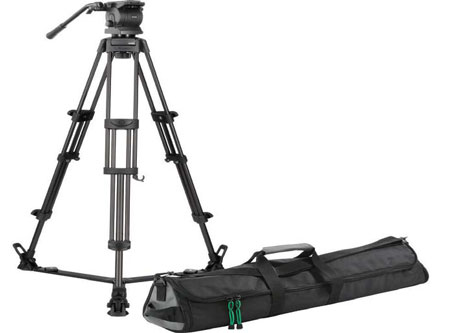
Libec RS-250D tripod Shooting run-and-gun style may seem a far cry from using a camera rigged cinestyle, with matte boxes, flags, filter holders and focus assist tools, where the weight and balance changes sometimes shot to shot. But news shooters have their own variety of optional extras, including big or small batteries, on camera lights, wireless mic receivers and video transmitters.
When Miller designed its Compass 23 tripod system, it aimed for a lightweight but robust support for the camera package that can handle a counterbalance range of 8–30 pounds. It also provides a 120mm sliding camera plate with 60mm of travel to reset the camera balance as accessories are added or taken off.
The Compass 23 offers three selectable positions of high-performance pan and tilt drag, plus a zero position.
Most camera crews use a tripod at eye level for interviews and standups. But for shooting steady B-roll material it’s handy to be able to go high and low.
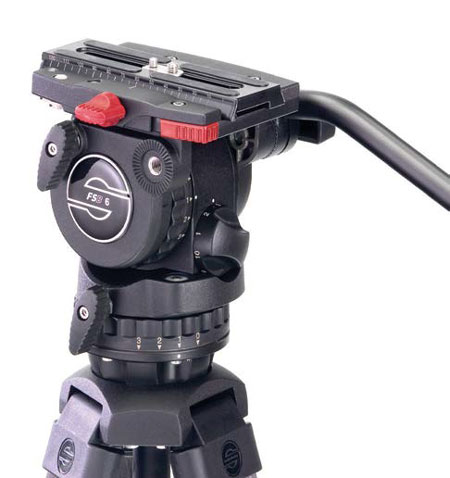
Sachtler FSB8 tripod with Touch & Go plate and SpeedLock system Shotoku addressed this need with its spreader-less TT-66/L/S tripods, featuring extreme low angle shooting or the flexibility to add stability where a floor or midlevel spreader might not be practical. The tripods employ a simple twist lock grip to allow quick, easy and individual adjustment of each leg length.
The speed with which a news shooter can move from setup to setup is dictated by how quickly the camera can be mounted and dismounted, and the tripod deployed and broken down for carrying.
Sachtler’s FSB8 tripod with Touch & Go plate and SpeedLock system addressed just this in a lightweight package. For cameras weighing less than 20 pounds, the three section TT 75/2 CF telescopic tripod quickly erects to a steady camera platform, then collapses to a portable 17 inches.
Most days a news shooter doesn’t have time to use a slider, but Libec designed their tripod heads so if there is a need for a slider, skater, etc., they can quickly mount the fluid head and get shooting.
The RS-250D (for smaller cameras) and the RS-450D (for mid-sized cameras) feature a 75mm ball for quick leveling on a tripod. But the bottom of the ball is cut flat or quick bolting to slider, skater, jib arm or other camera support device.
